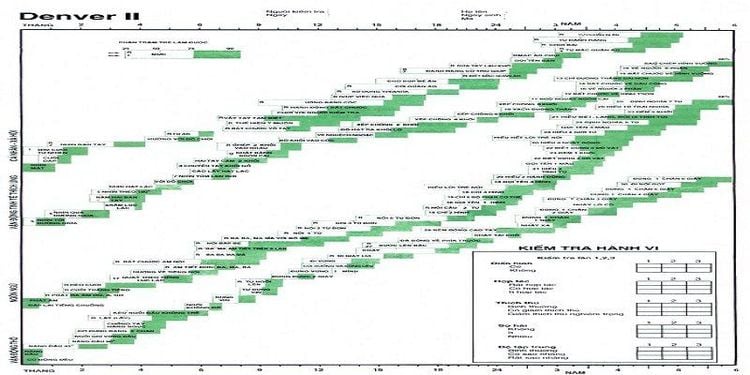This is an automatically translated article.
Children under 6 years old are the age of rapid physical, mental and motor development. Physical growth is assessed and monitored through biomarkers and energy charts. In addition, to assess and monitor psychomotor development, it is necessary to use psychological testing. Currently, the Denver Test is applied by many countries around the world and is considered as the first tool to assess psychomotor development in children.
1. What is the Denver Test for Psychomotor Development?
Test Denver to assess psychomotor development was built in 1967 at the Denver Colorado medical center (USA) and modified to Denver II in 1992. Test Denver with simple instruments, easy to perform and has The system should be applied by many countries around the world to assess and screen children with psychomotor retardation.
Test Denver includes 125 items and is divided into 4 areas as follows:
Adaptive fine motor area: Hand-eye coordination, ability to manipulate small objects, mastery of small muscle groups. The social-personal area: The child's interactions with others and the child's ability to fulfill individual needs. Language area: The child's ability to understand and use language. Gross motor area: The child's ability to crawl, sit, walk, run... to master and coordinate large muscle groups. The percentage of children doing it by age is shown in 25%, 50%, 70%, 90% in white and blue boxes.
2. In which cases is the Denver test to assess psychomotor development applied?
Denver test to assess psychomotor development is indicated in the following cases:
Children under 6 years of age with suspected mental and motor retardation. Children with physical diseases need to be monitored for psychomotor development. The child has problems with pregnancy and obstetric history. Besides, assessment of psychomotor development by Denver test is contraindicated in the following cases:
The patient is tired, is using psychiatric drugs or has a serious physical illness. Children who are not accompanied by caregivers or children with attention-deficit hyperactivity, oppositionalism, aggression...

Trẻ em dưới 6 tuổi có dấu hiệu chậm phát triển cần được Test Denver
3. Denver test execution process
Denver test assesses psychomotor development by psychiatrists, psychologists, specialized nurses and the following technical facilities:
The testing room meets the requirements: Yen Quiet, well-lit, tables and chairs or seats suitable for each child's age. Denver II sheet, test manual, blue, red, purple 3-color pen, ruler, pencil and test kit. The steps to perform the Denver test are as follows:
3.1. Checking records The doctor checks that the medical records are correct as required by the Ministry of Health.
3.2. Examining the patient Before performing the test, the doctor should do:
Explain to the caregiver the purpose of the test and ask for cooperation. Observe whether the child is healthy and awake enough to participate in the test. Use good communication skills to create a friendly, fear-free environment for your child. 3.3. Performing the Test The doctor draws the age line by: Taking the test date - date of birth, age in months and days, for children younger than 2 years old minus the week of premature birth. The doctor locates the age on the age division line and plots the age line.
The doctor proceeds to make the entries and write the notation.
Check for three consecutive goals that are completely to the left of the age line, if at least one item can't be done, continue to move left, until three consecutive items do, then stop.
The doctor checks all the items that the age line passes, continue to do the items to the right of the age line until three consecutive items can be done, then stop.
The doctor can ask the child's parents for some items marked with a small R on the form and does not need to be checked.
The doctor signs letters corresponding to the following contents: The green letter T means that the child can do it or the parents have seen the child do it; The letter K is red if the child can't do it or the parents say the child can't do it. The letter T is purple if the child refuses to do it or the parents do not answer clearly.
Next, the doctor conducts an assessment of each item as follows:
Progression: I lies completely to the right of the age line (meaning that the child can do it while 90% of the children of the same age cannot do it). Normal item: K or T of items to the right of the age line. K or T of items where the age line passes through the white part 25 - 75%. Doubtful item: K or T of the item where the age line intersects the green part (because 75-90% of children of the same age or younger can do it but they can't). Delayed items: K or T of items to the left of the age line (when more than 90% of children the same age or younger do). Evaluate the entire test.

Kết quả Test Denver giúp bác sĩ đánh giá chính xác
The doctor evaluates the whole Denver test according to the following criteria:
Normal: The whole test has no items of retardation, there is one item of suspicion. Suspected retardation: Entire test has one slow item and over 2 suspect items. Developmental retardation: When there are more than 2 suspect items and more than 1 retarded item. The doctor evaluates each area as follows: Forward the age line to the left or right. Will stop at the age level so that the area is free of slow and suspicious entries. Areas of developmental age are equivalent to where the age line stops on the age scale.
Conduct behavioral assessment: This assessment is filled in after the test in the behavioral manifestations in the rectangular box in the lower right corner of the test sheet.
The doctor writes the test result report on the test sheet or the medical record, the medical record and explains to the caregiver about the test results.
4. Follow-up after performing the Denver test to assess psychomotor development
When performing the Denver test, the doctor needs to monitor a number of issues as follows:
The doctor should encourage and praise the child after each item the child cooperates with. If the child is tired and refuses, the doctor should stop and make another appointment as soon as possible. If the child has a developmental delay, the doctor needs to consult and guide the family to stimulate the child to develop better. Where the behavioral assessment item is problematic, additional screening tests for autism or affective behavior disorder should be performed. The Denver test is applied by many countries around the world and is considered as the first tool to assess psychomotor development in children. This technique is performed by psychiatrists, psychologists, and specialized nurses.
Please dial HOTLINE for more information or register for an appointment HERE. Download MyVinmec app to make appointments faster and to manage your bookings easily.













